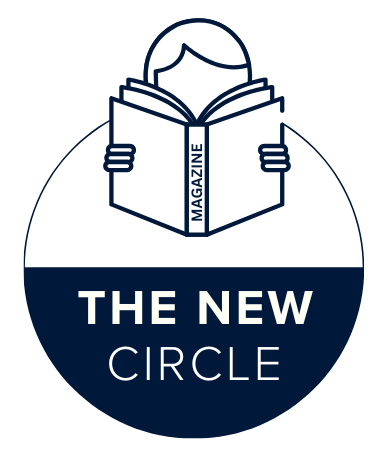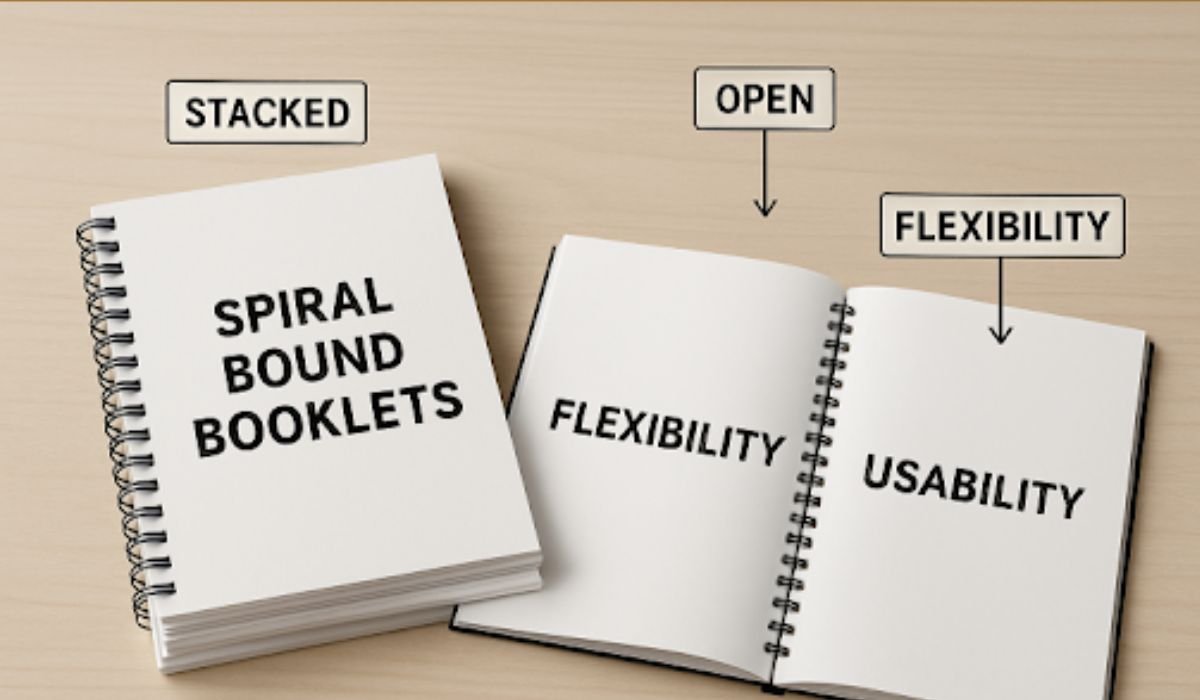Key Takeaways
- Durability: Spiral binding offers strength, keeping pages securely in place even with heavy use. The coils prevent pages from easily tearing out, ensuring your booklet remains intact after repeated handling.
- Flexibility: Allows booklets to lie flat and fold 360 degrees for effortless reading or writing. This flexibility means readers can comfortably write, sketch, or reference material without needing to hold the book open.
- Versatility: Ideal for a broad range of booklet sizes and page counts. Whether your project is compact or extensive, spiral binding adapts to your needs.
- Customization: Coils are available in a variety of colors and materials, allowing for unique branding and visual impact. You can even choose different cover stocks and finishes to match your branding or specific event themes.
When planning your following booklet, one of the most important decisions you’ll make is the choice of binding. The proper binding method impacts not only how your booklet functions on a day-to-day basis but also its professional appearance, usability, and durability over time. Many organizations are turning to booklet printing that has spiral bound to fulfill a variety of needs—whether for educational manuals, company handbooks, or creative portfolios—because it’s reliable and visually appealing. Choosing the proper binding might seem like a small detail, but it can be the difference between a booklet that feels premium and performs well and one that falls apart or proves awkward to use. From schools and non-profits to major corporations and small businesses, spiral binding continues to gain favor for its practicality and visual appeal.
Spiral binding, also referred to as coil binding, remains a versatile and popular solution in today’s print markets. As you explore options for your booklet project, understanding the unique advantages of spiral binding can help ensure your materials not only look impressive but also withstand frequent use and last as long as you need them. Compared to other binding methods, such as perfect binding, which glues pages together at the spine, or saddle stitching, which uses staples, spiral binding stands out for its ability to accommodate different booklet thicknesses and provide ease of use. This versatility makes it attractive for many different applications, and it’s especially popular for materials that need to remain functional and professional-looking over time.
Durability and Longevity
When it comes to materials that are used repeatedly—such as training guides, workbooks, or maintenance checklists—durability is crucial. Spiral binding excels in this area. The continuous plastic or metal coil threads through punched holes, holding every page in place with less risk of separation or wear compared to staples or simple glue. The binding isn’t affected by frequent page turning or opening, so your booklet maintains its integrity throughout its lifetime. This durability makes it especially well-suited for environments where your booklets might be handled by many people or used daily. Whether your booklets are passed between employees or clients, or shuffled through a busy classroom, spiral binding ensures every page stays protected and usable. Moreover, the sturdy coil resists bending, meaning even if your booklet is tossed into a bag or dropped onto a desk, it will continue to look crisp and professional.
Flexibility and Ease of Use
One of the hallmark features of spiral binding is its flexibility. Unlike perfect binding or saddle stitching, spiral-bound booklets can open completely flat—making both hands free for note-taking, following instructions, or referencing visual content. Even more, the pages can fold back on themselves a full 360 degrees, so you can view just one page at a time without damaging the spine or losing your place. This feature is particularly valued in educational settings, cookbooks, planners, presentations, and creative portfolios. Students often need to take notes or highlight text, so the ability to lay the workbook flat is a practical advantage. Chefs or hobbyists can keep their recipe books propped open at the exact page needed, without wrestling with the binding. In meetings or presentations, the presenter can fold the booklet back, holding it in one hand, while keeping notes visible in the other.
Versatility in Page Count and Size
The adaptability of spiral binding is exceptional. Whether your project is a slim tutorial with just a handful of pages or a comprehensive reference manual with over 300, spiral coils come in a wide range of thicknesses to accommodate. Furthermore, spiral binding works with all print sizes—from small pocket guides to large landscape presentations—making it a solid choice for both unique and standard booklet formats. This breadth means you are not constrained in your design choices, allowing you to create precisely the booklet you envision for your readers’ needs. Spiral binding accommodates thicker materials and oversized pages, making it ideal for artistic portfolios, architectural plans, or any project where visuals and tactile engagement are essential elements. If you’re producing custom projects, the ability to choose non-standard dimensions can set your materials apart and ensure they serve specialized uses effectively.
Customization Options
Your brand and content deserve to stand out. Spiral coils are available in a broad palette of colors and finishes, making it easy to match your company’s brand or choose a vibrant accent that adds impact to your printed piece. You can further customize by selecting between plastic or metal coils, transparent or custom-printed covers, and various paper stocks. This level of customization ensures each booklet leaves a memorable impression on its reader. Branding becomes seamless when you use coordinated coil colors, custom cover designs, or high-quality papers to reflect the ethos and priorities of your business or project. Options such as glossy or matte finishes, embossing, and specialty papers can significantly enhance the perceived value of your booklet, transforming an introductory informational text into a keepsake or portfolio piece. Moreover, personalizing each aspect of the booklet can help it function as an effective marketing tool or corporate handout, making the investment in quality worthwhile.
Cost-Effectiveness
Despite delivering durability and professionalism, spiral binding remains budget-friendly—whether you’re printing a handful of booklets or thousands. Without the added costs that sometimes accompany more labor-intensive binding processes, spiral binding often strikes the perfect balance between appearance and affordability for businesses and organizations of all sizes. For more insights into the economics of print projects. Thanks to lower setup costs and fast turnaround times, spiral binding is an ideal choice for short runs, pilot programs, or rapidly changing information needs that require constant updates. Cost savings do not mean compromise; with digital printing technology, you can still obtain vivid images and clean layouts, all professionally bound by durable coils at a reasonable price. The simplicity of the process further ensures that projects can be scaled up or down depending on your specific needs and budget constraints.
Environmental Considerations
For those committed to sustainable practices, spiral binding provides eco-friendly possibilities. Many print shops offer recycled paper options and eco-conscious inks, and both plastic and metal coils are often recyclable through standard facilities. Additionally, the durability of spiral binding ensures that your materials last longer, resulting in less frequent reprinting and reduced overall waste. Choosing recycled coil materials and responsibly sourced paper enables organizations to reduce their carbon footprint while still producing a high-quality product. Businesses and institutions are increasingly prioritizing environmentally responsible choices as part of their public-facing values, and spiral-bound booklets can be a powerful part of that narrative.
When to Use Spiral Binding
Ideal Applications
- Training manuals and workbooks
- Product catalogs and inventory lists
- Recipe collections
- Conference materials or visitor guides
- Planners, calendars, and creative portfolios
This binding’s flexibility and reliability make it perfect for any scenario where frequent handling or note-taking occurs, or where pages need to lie flat for easy reference while working. If you require a booklet that serves both functional and aesthetic needs—such as a catalog that doubles as a marketing tool, or a portfolio that must impress clients while enduring continual use—spiral binding is especially well-suited. Educational institutions, professional service providers, artists, and corporate trainers all benefit from the practicality and polish that spiral binding can provide.
Conclusion
Spiral binding is a standout option for booklet printing, offering a blend of strength, usability, and vibrant customization. Its ability to cater to a wide range of page counts and sizes, lie completely flat, and withstand heavy use sets it apart from other binding methods. Combined with eco-friendly options and cost efficiency, spiral binding is a practical, versatile solution for any booklet printing project on your horizon. Regardless of your industry or the purpose of your booklet, selecting spiral binding is a step toward greater convenience, durability, and visual impact, and can help ensure your investment in printed materials delivers lasting value.
YOU MAY ALSO LIKE: The Essential Guide to SOA OS23 Demolition Certification in Italy

